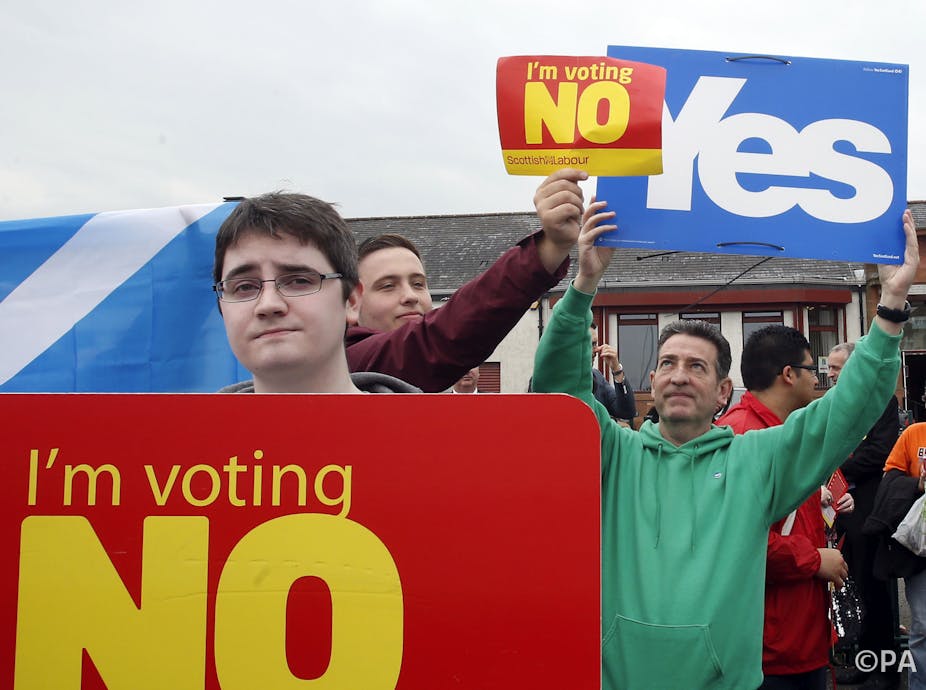It seems Scottish voters are warming to the whole independence idea, then – bucking the trend that the experts have been telling us for months they’re almost bound to follow.
The poll that this week put the Yes vote ahead for the first time caused Westminster to panic. But it may also be causing a stir among pollsters because it challenges a long-recognised feature of referendum voting behaviour.
The shared conventional wisdom is that, as polling day approaches, support for change – or usually the Yes vote – will fall away. As the campaigning draws to a close, wavering voters tend to move towards the option they know and feel safer with, and end up voting No.
But the Scots appear to be failing to play by these rules. And that has election buffs in a state of some confusion.
YouGov, which produced Sunday’s poll, and its president Peter Kellner must be surprised. In May 2012, Kellner offered some advice to Scotland’s First Minister Alex Salmond ahead of his referendum campaign.
The swing back to the status quo happened towards the end of both the 1975 UK referendum on Europe and the 2011 referendum on electoral reform, he said, “so, to have a good chance of winning an independence referendum in 2014, I reckon Alex Salmond should be aiming for a Yes lead in the polls leading up to the campaign of approaching two-to-one”. In fact, YouGov’s figures at the campaign launch shortly afterwards showed a No lead of 57% to 33%.
Salmond’s characteristic response was that he preferred to enter campaigns as the underdog. Kellner’s verdict, a few months later: “As a shrewd and intelligent man, he must know his mission is impossible.”
Not surprisingly, the first Scottish devolution referendum in 1979 has been much discussed during this campaign and it contributes some particularly persuasive evidence to the “swing-back to status quo” thesis. As Kellner noted, with just two weeks to go to polling day, Yes supporters outnumbered their opponents by around three-to-two. But, as the poll grew closer, that number rapidly dwindled, leaving virtually a dead heat. In the end, 33% voted Yes, 31% voted No and 36% didn’t vote. With the rules in that referendum requiring a Yes vote of at least 40% of the whole electorate in order to win, devolution was off the agenda for the next 18 years.
Academic political scientists crunch different data in different ways but come up with similar findings. Canadian Larry LeDuc and the University of Reading’s Alan Renwick have, between them, studied polling data from 34 international referendum campaigns, comparing each final result with a poll taken around a month earlier.
LeDuc looked at 23 referendums before 2000, including Quebec’s two independence referendums in 1980 and 1999, the Danish and French Maastricht Treaty referendums in 1992, and Australia’s republic referendum in 1999.
He found that Yes support fell during the final campaign month in 17 cases. In 14 of these, it fell by more than 10%. In only one case – a non-binding referendum on electoral reform in New Zealand in 1992 – was there a 10% move the other way.
Renwick looked at 11 post-2000 referendums and found a very similar picture.
In only one case was there any significant late rise in Yes support, and that was in Italy’s triple-question electoral reform referendum in 2009 – in which, incidentally, all three overwhelmingly ‘Yes’ votes were ultimately invalidated, due to the under-50% turnout.

The turnout in the UK’s 2011 Alternative Vote referendum fell well short of 50% too, despite the desperate, possibly dubious, but unarguably effective last-minute efforts of the No to AV campaign.
In the 25 polls published between mid-February and mid-April 2011, the Yes campaign was ahead in 12, the No campaign in 12, and in one they were level. In the subsequent 16 polls, the No campaign was ahead in every one and by steadily increasing margins, although only one recorded a lead as large as the actual 68% to 32% result.
The final week of that referendum saw the No to AV campaign focusing on the alleged unaffordable cost of the referendum with a series of emotive posters of a soldier, a new-born baby and a sick child, accompanied by the slogans that they needed variously bullet-proof vests, maternity units and new cardiac facilities, rather than an alternative voting system.
If the Better Together campaign can’t produce something considerably more elevated than that in the next few days, it’s hard to see Scottish voters, who already claim to feel patronised, reversing their challenge to the conventional “swing back to status quo” wisdom.

